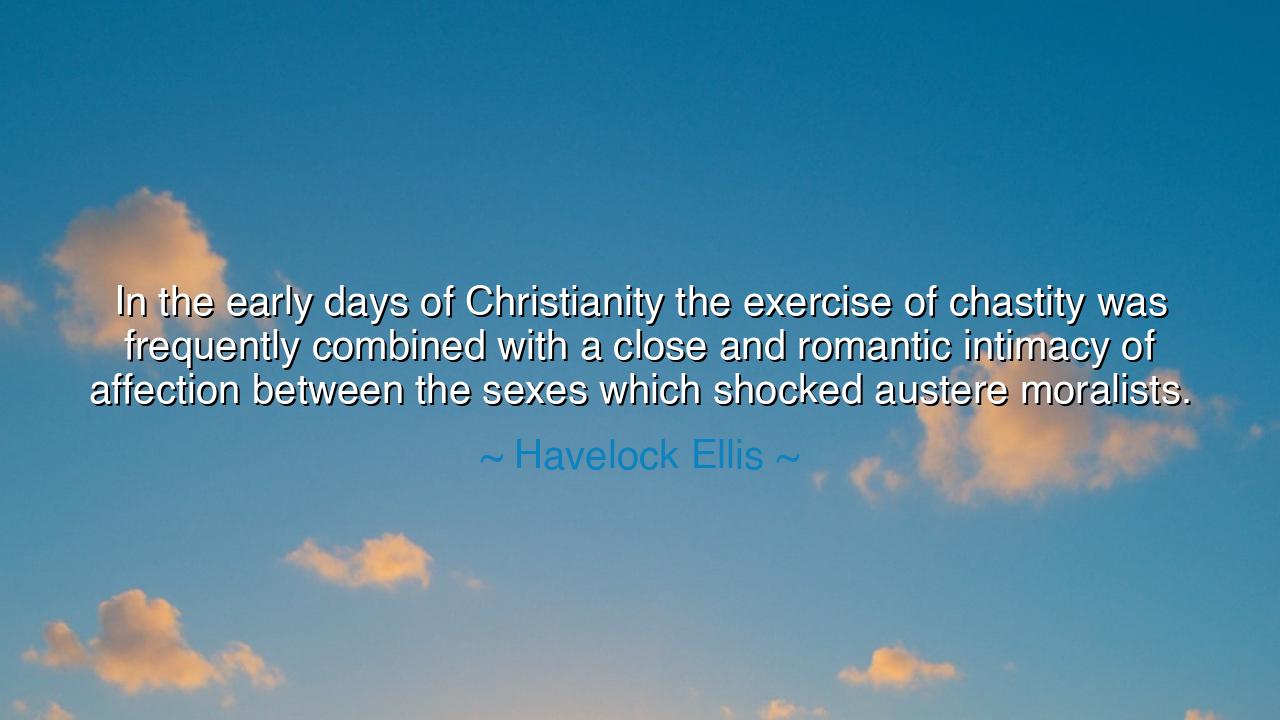
In the early days of Christianity the exercise of chastity was
In the early days of Christianity the exercise of chastity was frequently combined with a close and romantic intimacy of affection between the sexes which shocked austere moralists.






"In the early days of Christianity, the exercise of chastity was frequently combined with a close and romantic intimacy of affection between the sexes which shocked austere moralists." – Havelock Ellis. In these words, Ellis touches upon a delicate and profound truth about the evolution of human relationships, particularly in the context of early Christianity. His reflection reveals a tension between the ideals of chastity and the human need for affection and intimacy. In the earliest days of Christianity, the practice of chastity was often seen as a form of spiritual purity—one of the cornerstones of ascetic life. However, this ascetic ideal did not always negate the deep emotional and romantic bonds that could form between the sexes. In fact, the early Christians found ways to express both spiritual discipline and profound emotional connection, a combination that was both radical and difficult for more austere moralists to comprehend.
In the ancient world, chastity was often associated with spiritual purity and self-control. In the Hellenistic and Roman eras, many philosophers, like Socrates and Plato, viewed sexual restraint as an important virtue. However, their understanding of chastity was not just physical; it was tied to inner discipline and the pursuit of higher philosophical ideals. For the early Christians, this concept of chastity took on a new spiritual dimension. It was no longer simply about renouncing physical desire, but about seeking closeness to God through purity and devotion. St. Paul, in his letters, encourages the faithful to remain chaste but also to love deeply, showing that emotional connection and spiritual discipline were not mutually exclusive.
This paradox of chastity combined with romantic affection can be seen in the lives of early Christian saints and martyrs. St. Agnes, a young Christian virgin, was revered not only for her chastity but for the deep love she showed to God and others. Her affection for her faith was not detached or austere but was filled with a genuine connection to the world around her. In this way, romantic intimacy did not have to be at odds with spiritual purity. St. Francis of Assisi, too, exemplified a radical combination of devotion and love for all creatures. His compassion was deeply affectionate, and yet he adhered to the strictest forms of chastity, showing that the true essence of love, whether divine or human, is not merely physical, but a spiritual bond that transcends earthly limitations.
The austere moralists of Ellis's time, who viewed such emotional intimacy with suspicion, were, in a sense, part of a long-standing tradition that sought to separate passion from purity. The Victorian era, with its rigid moral standards, saw sexual desire as something that could taint the soul, and it viewed emotional attachment as something dangerous, even immoral, when it went beyond a certain boundary. Yet, history teaches us that the deeper connections between human beings, particularly in the context of love, are not something to be feared but cherished. Romantic affection—when grounded in mutual respect and spiritual alignment—can elevate the human experience, making it more profound and meaningful.
Consider the life of Theodore of Sykeon, a 6th-century Christian hermit and mystic, who practiced a form of asceticism but maintained deep affection and intimacy with his community. His life was an embodiment of the balance between chastity and the emotional bonds of love and affection that define human connection. He did not shy away from the emotional warmth that comes with companionship, but he expressed it in a way that was spiritually enriching, showing that love and chastity need not be contradictory. This delicate balance, between affection and asceticism, is a lesson in how to navigate our own emotions while staying true to our spiritual or personal values.
The lesson we draw from Ellis’s reflection is that love, in its truest sense, is not limited to the physical realm but extends into the spiritual. Chastity is not a denial of human connection but a devotion to something higher. It is a call to recognize that our emotional and romantic bonds are part of the human experience—not something to be feared, but something to be guided by our higher purposes. True love is pure, not because it denies desire, but because it seeks to connect on a deeper level, beyond the physical.
In our own lives, we should strive to embrace love in all its forms—whether romantic, spiritual, or platonic—and recognize that these forms can coexist harmoniously. Let us not separate our emotions from our spiritual pursuits but seek to integrate them in a way that brings depth to both. Like the early Christians and saints who balanced chastity with profound affection, we must find ways to connect deeply with those around us, without fear of judgment, and without losing sight of our highest ideals. Love, in all its purity, is a force that connects us to the divine and to each other. It is a sacred bond that elevates the soul and transforms the world.






AAdministratorAdministrator
Welcome, honored guests. Please leave a comment, we will respond soon